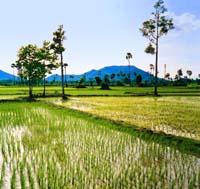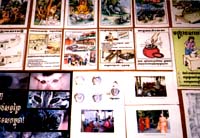|
|
|
|
 |
|
Education and training
 |
 |
 |
Monks work among the farming villages of Cambodia and their surrounding forests |
Training workshops
To increase the long-term sustainability of the project, Mlup Baitong delegates activities to the monks in the pagodas. This is backed up by training courses focusing on decision-making, accounting and fundraising, developed with the Provincial Department and the District Office of Cults and Religions. Skills among monks and villagers have been strengthened in 2004 through 6 training workshops:
• A five-day training workshop on knowledge and skills to improve environmental management in the pagodas for 16 key monks and 4 lay achars who then conducted their own five-day training workshop for 180 people from 59 villages.
 |
 |
 |
Posters on a community noticeboard outside a pagoda in Kampong Speu province, Cambodia |
• A four-day workshop in management, accounting and fundraising for 16 monks and 8 achars from 10 pagodas.
• A six-day training of trainers workshop in Kampong Thom for key monks and lay assistants to teach environmental education and awareness, and a similar three-day workshop in Kampong Speu.
• A five-day training for 9 head monks and one Mlup Baitong staff member on fruit tree propogation was held at Preak Leap National School of Agriculture.
Networking and education
1. 2 network meetings have been held to disseminate information among monks, nuns, achars and villagers living around the 14 pagodas in the project.
2. A five-day workshop for trainers – one monk and one achar from each pagoda attended and then returned to their communities as trainers. The following elements made up the training:
• Training methodology/presentation skills
• Water is our life
• Community development through pagodas
• Beliefs and habits of the local community
• Value of the forest
• The use of natural resources
• Hunter and elephant
• Keeping the environment clean
• The use of forest products
• Tree planting
3. Educational training continued with the production of 200 posters for pagoda bulletin boards (6 new bulletin boards were erected in pagodas). 17 environmental lectures were conducted in Kampong Speu pagodas and 23 lectures in Kampong Thom pagodas – attended by 575 monks, school children and teachers.
4. Environmental information is disseminated through the following methods: monastery bulletin boards, pictures, posters, slogans, guidance on waste management, tree planting, use of water filters, construction of ICS, wildlife conservation, and the Buddha’s in the forest.
5. Extension lessons by government officers were conducted in Sambour village for ten days on the topics of forests, propagation, sanitation, pollution and wildlife conservation and were attended by 165 villagers.
6. An environmental radio broadcast by closed-circuit radio is made in each pagoda almost every Buddhist holy day (twice a month). Sometimes the broadcast is replaced by a speech from the head monk, or the monk responsible for conservation activities on pagoda land –attendance is between 75 and 300 people.
7. Video shows are popular: 21 were held in pagodas for the local villagers. They cover the following topics: waste management, composting and tree planting, impact of using chemical pesticides and natural resource management. 2,440 people attended these shows.
New 2004 initiatives
A Buddhism and Environment Service Manual has been produced in Khmer and English with practical guidance on 12 environmental activities.
750 metre fire road has been constructed on the south side of Sambour community forest, 239 villagers participated in its construction.
A village library and extension centre has been established in Sambour pagoda stocking conservation material.
A new pagoda has been selected in Kampong Thom province to extend the monk and environment programme.
Mlup Baitong and the World Bank were our partners in hosting the Phnom Penh Conference on Buddhism and the Environment in May 2004. >see Phnom Penh 2004
To contact ARC's sister group in Cambodia, the Association of Buddhists for the Environment, link here.
|
 |
|
|
|
|
|

